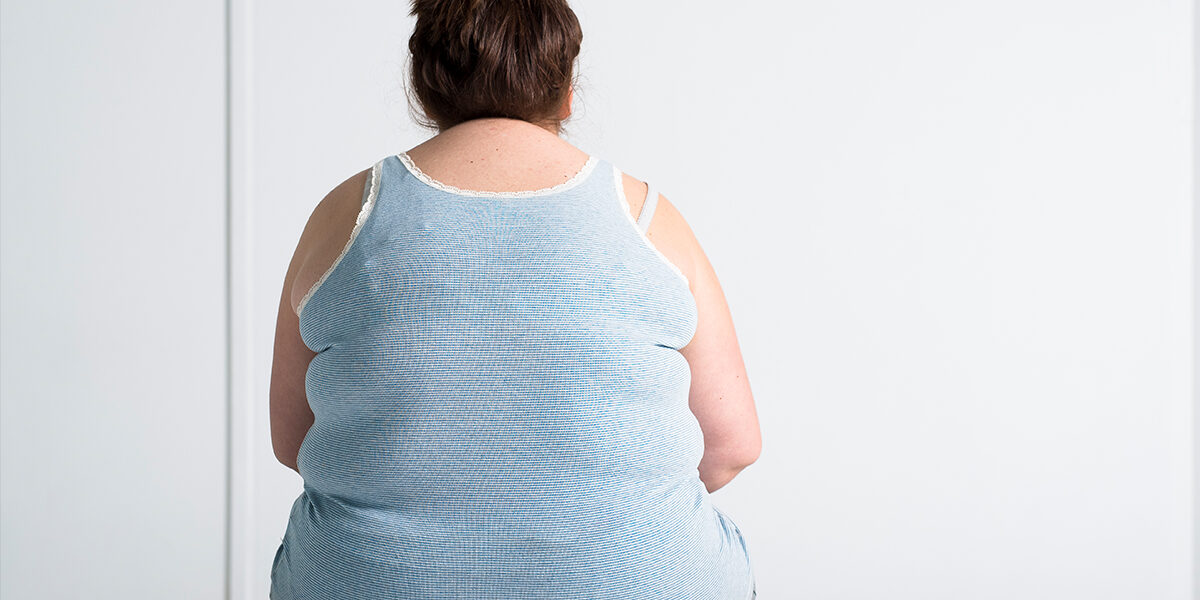
WHAT IS THE “KANLIOZ TECHNIQUE”?
Kanlioz Technique is the procedure of simultaneous administration of gastric balloon and gastric botulinum toksin to the patient for the treatment of obesity, which was first performed by Assoc. Prof. Dr. Murat KANLIÖZ for the first time in the world. The technique was described in an article, reporting our experiences with KANLIOZ TECHNIQUE. In 2020, our article was published in “Surgical Laparoscopy Endoscopy Percutaneous Techniques”, a highly respected and prestigious American Medical Journal, which specializes in publishing new technical methods (1).
WHAT IS THE PURPOSE OF PERFORMING THE “KANLIOZ TECHNIQUE”?
KANLIOZ TECHNIQUE aims to benefit from combined effect of “Gastric Balloon” and “Botulinum Toxin A Injection to the Stomach” simultaneously. The technique allows for faster weight loss.
HOW MUCH WEIGHT CAN I LOSE WITH THE “KANLIOZ TECHNIQUE”?
Kanlioz Technique: Thanks to this technique, patients lose an average of 20-22% of their weight in a 6-month period, provided that they follow their diets.
IS IT A CORRECT APPROACH TO PERFORM “KANLIOZ TECHNIQUE” ON EVERYONE AND WHY?
KANLIOZ TECHNIQUE is recommended for those who seek to lose weight faster, those who need to lose weight faster, and those with severe obesity. Although the technique is a highly effective method in which both procedures are combined, it should be kept in mind that the side effects of both procedures may also coexist. This should therefore be discussed with the patient and decided accordingly. We do not recommend KANLIOZ TECHNIQUE especially for patients with psychological problems.
Another point to consider is to check the condition of the mechanism that controls gastric output. An endoscopic examination of the structure called PYLORUS, which controls the gastric outlet, and which works like a kind of “valve” consisting of a muscular structure and ensures controlled emptying of the stomach, should be performed and the treatment method to be followed should be decided afterwards. If, during endoscopy performed for check-up purposes, the PYLORUS closes completely with the mild mechanical stimulus applied around it with the tip of the endoscopy camera, that is, if it is functional (Normotonic Pylorus), there would be no harm in administering botulinum toxin and balloon together, and the procedure would definitely yield an effective weight loss. However, if the Pylorus fails to close completely (Hypotonic Pylorus) or if it does not close at all and is completely open (Atonic Pylorus) upon mechanical stimulation applied to the pyloric region with the tip of the endoscope, the effects of gastric botulinum toxin and gastric balloon would be limited. In the case of patients with an “atonic” or “hypotonic” pylorus, it is necessary to perform the procedure called “PYLORIC REVISION” first, followed by gastric botulinum toxin and then gastric balloon during the same session (You may find further information on Pyloric Revision in the PYLORIC REVISION PROCEDURE under the heading Endoscopic Treatments for Obesity). If gastric botulinum toxin and gastric balloon are administered in combination with PYLORIC REVISION to those who have HYPOTONIC and ATONIC pylorus, KANLIOZ TECHNIQUE would again yield an effective weight loss.
HOW IS THE “KANLIOZ TECHNIQUE” PERFORMED?
Those who are found to have NORMOTONIC PYLORUS on endoscopic examination are first treated with “Botulinum Toxin A” procedure and then a gastric balloon is administered.
In administrating ”Botulinum Toxin A to the stomach”, first the inside of the stomach is viewed through the camera of the endoscopy device, and then 200 units of crystallized “Botulinum Toxin A” diluted with 20 cc saline is administered by injecting 1 cc into each injection site at a total of 20 different points, including 10 different points in each of two circular areas approximately 5 cm apart and parallel to each other, close to the gastric outlet, and at a 45° angle to the stomach wall, using endoscopic injection needles that are inserted into the stomach through the canals in the endoscopy device, thus paralyzing the stomach muscles in a controlled and temporary manner for about six months (2).
“Gastric Balloon” is used to occupy 350-500 cc of the total volume of the stomach, i.e. 1500-2000 cc, with a balloon in order to ensure that the stomach gets full with less food and to create a feeling of satiety. Another advantage of the gastric balloon is that it allows the stomach to empty later, as the balloon blocks the gastric outlet like a plug. Longer periods of satiety are achieved as the stomach gets full with less food and takes longer to empty. This helps to ensure that weight loss is achieved by consuming less food. There are two mechanisms involved in the development and maintenance of satiety. The first is a rise in blood sugar, but this has a weak effect. The second is satiety caused by the filling of the stomach and the pressure of the stomach contents on the stomach wall, which is a strong mechanism of satiety. Gastric balloon induces prolonged and potent satiety.
However, it is recommended to perform PYLORIC REVISION during the same session before performing KANLIOZ TECHNIQUE for individuals with ATONIC or HYPOTONIC PYLORUS structure.
PYLORIC REVISION involves filling around the pylorus with 150 cm long injectors endoscopically inserted into the stomach and narrowing the opening there. This minimizes leaks from the stomach into the small intestine and prolongs emptying time.
KANLIOZ TECHNIQUE procedures are performed during the same session once the PYLORIC REVISION is completed.
BY WHICH MECHANISM IS WEIGHT LOSS ACHEVED IN “KANLIOZ TECHNIQUE”?
KANLIOZ TECHNIQUE is a method involving the combined administration of “Gastric Balloon” and “Botulinum Toxin A” injection to the stomach. “Botulinum Toxin A” is used to temporarily paralyze the muscles in the region close to the gastric outlet for a period of 6 months and accordingly, the gastric emptying time is prolonged and longer periods of satiety are achieved. In the gastric balloon treatment, a portion (350-500 cc) of the stomach volume (1500-2000 cc on average) is occupied by the balloon. This helps to fill the stomach sufficiently with less food in proportion to the volume of the balloon, thereby ensuring satiety. The gastric balloon also acts as a plug in the gastric outlet and contributes to the satiety mechanism by prolonging the gastric emptying time.
DOES “KANLIOZ TECHNIQUE” REQUIRE ANY PREPARATION BEFORE PROCEDURE?
Yes, it does. If the patient who will undergo the procedure is taking any blood thinners (aspirin, coraspin, coumadin, etc.), he/she should stop taking them 5 days before the procedure. It is important that there are no food residues in the stomach in order to obtain a sufficiently clean image during the procedure, so oral intake of any liquid-solid food and medication should be avoided 12 hours before the procedure.
IN HOW MANY MINUTES IS THE “KANLIOZ TECHNIQUE” PERFORMED?
All the procedures (including mild narcosis) involved in KANLIOZ TECHNIQUE are completed in about 20-25 minutes. The patient is discharged after 2 hours. In the next 2 hours, the patient can start eating and resume his/her daily life.
HOW DO I PREPARE FOR THE PROCEDURE IN THE HOSPITAL, DO I FEEL ANYTHING DURING THE PROCEDURE?
Following the necessary preliminary preparations of the patient, a vascular access is established following fasting for 12 hours, then the patient is slightly anesthetized under the supervision of an anesthesiologist in the standard endoscopy ward in the hospital, and while the patient is asleep with normal breathing and without feeling anything, the endoscopy device is inserted through the mouth to reach the stomach, and at that point, a preliminary examination is performed and if there is no medical drawback, “Botulinum Toxin A” is injected into the stomach and the endoscopy device is removed. Then the balloon set is inserted through the mouth and lowered into the stomach. The endoscope is re-inserted through the mouth and advanced to the stomach, and once the balloon reaches the stomach, the guide wire in the tube connected to the balloon set is removed and the gastric balloon is inflated with blue-colored saline under the supervision of the camera, taking into account the volume of the stomach. This procedure is absolutely painless, and the patient does not feel any pain.
HOW SOON CAN I START EATING AFTER “KANLIOZ TECHNIQUE”?
You can start eating 2 hours after the procedure.
DO I NEED TO BE HOSPITALIZED FOR THE “KANLIOZ TECHNIQUE”?
NO, YOU DON’T. “KANLIOZ TECHNIQUE” is a procedure that does not require hospitalization. The procedure is completed in a total of 4 hours, including preparation for the procedure, performing the procedure and follow-up thereafter. The patient can then be discharged from the hospital and resume his/her daily life.
DOES “KANLIOZ TECHNIQUE” POSE ANY RISK?
Where the “Gastric Balloon” and “Botulinum Toxin A” are co-performed by experienced people, the risk it presents is no higher than the risk of the endoscopy procedure.
FOR WHOM CAN THE PROCEDURE BE POSTPONED AS A RESULT OF ENDOSCOPIC EXAMINATION?
If the endoscopic examination reveals active bleeding, active infection, suspicious mass lesion or obvious tumoral formation in the stomach, the procedure is terminated. In case of suspicious or obvious tumoral formation, the procedure is terminated after conducting a biopsy. In such cases, no procedures are performed for the treatment of obesity.
IS IT SAFE TO UNDERGO “KANLIOZ TECHNIQUE” DURING PREGNANCY?
We do not recommend administering “Botulinum Toxin A to the Stomach” during pregnancy as there are no reliable studies on this issue. We also do not recommend placing a gastric balloon during pregnancy.
IS IT SAFE TO UNDERGO “KANLIOZ TECHNIQUE” DURING BREASTFEEDING (LACTATION)?
No clinical studies have been conducted on the passage of “Botulinum Toxin A” into breast milk nor on its adverse effects on the infant. KANLIOZ TECHNIQUE can therefore be practiced during breastfeeding.
IS THERE A DIET I SHOULD FOLLOW AFTER “KANLIOZ TECHNIQUE”?
For maximum efficiency, we recommend avoiding foods in the carbohydrate group (sugar, bakery products, fruit, fruit juice, carbonated drinks, etc.) as much as possible. We also recommend consuming vegetables instead of fruits. There are no restrictions on protein and fat consumption, provided they are not overconsumed. Eating and drinking too much at once, as a past habit, may cause severe fullness, a feeling of pressure inside the stomach and nausea and vomiting, as the gastric emptying time is prolonged and a significant portion of the stomach volume is occupied by the balloon. Since this procedure aims to help you lose weight, it is recommended to reduce portions of food compared to the past.
CAN A NEW GASTRIC BALLOON BE INSERTED AFTER THE GASTRIC BALLOON IS REMOVED?
If desired, a new balloon can be inserted during the same session after the gastric balloon is removed. There is no need to wait for this procedure. Gastric balloon can be inserted repeatedly, there are no medical drawbacks.
HOW IS GASTRIC BALLOON REMOVED?
First the patient is made ready for the procedure by following the same steps as during gastric balloon insertion. Following 12 hours of fasting, the patient is put to sleep with sedation (mild anesthesia) given intravenously under the supervision of an anesthesiologist, and the stomach is accessed with an endoscope through the mouth. Through canals in the endoscopy device, a tube is sent into the stomach, which contains a piercing wire that can be removed in a controlled manner. These are controlled externally with endoscopic visualization. At this point, first the site where the balloon will be punctured is identified, then the tube inserted into the stomach through the endoscopy cannula is brought closer to the balloon, followed by opening the piercing wire in the tube, piercing the balloon and penetrating into the balloon. Then, while the tube is still inside the balloon, the piercing wire inside the tube is pulled out and removed. Meanwhile, the inner end of the tube is inside the balloon and the outer end is outside. Using a suction device called an aspirator connected to the outer end of the tube, the liquid in the balloon is drained. As soon as the liquid is completely drained from the balloon, the tube is pulled out of the endoscopic canal. Then, a cannula with two retaining apparatus at the tip is inserted into the stomach through the same canal. The grasping hooks are normally kept closed and can be opened with the camera at any time. The grasping cannula is opened in the stomach in a controlled manner and the emptied balloon is grasped by the grasping hooks of the cannula and the balloon is pulled out of the mouth using the endoscope.
HOW LONG DOES IT TAKE TO REMOVE A GASTRIC BALLOON?
A gastric balloon is removed in approximately 10-15 minutes (including mild anesthesia).
IS IT POSSIBLE TO ALTER THE VOLUME OF THE GASTRIC BALLOON BY ENDOSCOPE?
Some gastric balloons allow for increasing the volume of the balloon by accessing the stomach through an endoscope and filling it with more fluid, or reducing the volume of the balloon by draining some of the filled fluid.
WHY MAY IT BE NECESSARY TO CHANGE THE VOLUME OF THE GASTRIC BALLOON?
Patients may sometimes have complaints of too much pressure and compression from the balloon, which they cannot tolerate despite adjuvant therapies. In such cases, if the balloon placed is adjustable, the balloon volume can be reduced by endoscopy under anesthesia using a tube inserted into the balloon valve. In some cases, however, if the expected weight loss is not achieved and the patient has no complaints, the volume of the balloon is increased slightly to increase the balloon’s effectiveness.
WHICH ARE THE MOST COMMON DISORDERS EXPERIENCED AFTER “KANLIOZ TECHNIQUE”?
While placing the gastric balloon, the volume of the balloon is adjusted taking into account the anatomical structure and volume of the stomach. A gastric balloon inflated too much may cause severe feeling of fullness, pressure, nausea and vomiting. However, 10-15% of patients may experience a feeling of fullness, nausea and vomiting even if the balloon is inflated to the appropriate volume. Most of the symptoms in these cases are alleviated by simple medical treatments. The symptoms usually resolve spontaneously after the first 24 hours however 1-2% of patients may continue to have symptoms after 24 hours. In 0.5-1% of patients, the balloons are removed in the first week following the procedure for not tolerating the balloon.
Since “Botulinum Toxin A” injection into the stomach partially paralyzes the stomach muscles and slows down gastric emptying, 10-15% of patients may experience mild nausea and stomach cramps in the first 24 hours after the procedure.
Because of the co-administration of the balloon and “Botulinum Toxin A”, the patient may experience slightly more nausea than with each method alone. However, these side effects usually disappear spontaneously within 24-36 hours.
Such symptoms are usually not intolerable and occur in about 10-15% of patients.
DOES A STOMACH BALLOON BURST?
Theoretically, yes, the gastric balloon can burst. But this is very rarely the case. There are cases of balloon bursting reported in populations that habitually eat fish and chicken with bones.
IF THE BALLOON BURSTS, HOW DO WE KNOW IT HAS BURST?
The balloon is inflated with saline colored with methylene blue. If the balloon bursts, the urine color will be green due to the absorption of methyl blue into the bloodstream. Each patient is informed after the procedure that the balloon may have burst if they pass green urine. In such a case, the balloon is checked by endoscopic examination, and is removed if it has burst.
IF THE GASTRIC BALLOON BURSTS, DOES IT CAUSE INTESTINAL OBSTRUCTION?
Even if it has burst, it is very difficult for the balloon to pass from the stomach to the small intestine. However, there are some published cases, albeit rare, of a burst balloon passing from the stomach to the small intestine and causing obstruction, and sometimes bursting and being excreted in the feces without being noticed.
References:
- Kanlioz M, Ekici U, Tatli F, Karatas T. Efficacy of Intragastric Balloon Placement and Botulinum Toxin Injection in Bariatric Endoscopy. Surg Laparosc Endosc Percutan Tech. 2020 Dec;30(6):500-503. DOI: 10.1097/SLE.0000000000000829.
- Kanlioz M, Ekici U. How Taking into Account the Pyloric Tonus Contributes to Treatment Success While Administering Gastric “Botulinum Toxin A” for Weight Loss. Obesity Surgery (2020) 30:3365–3369. DOI: 10.1007/s11695-020-04556-7
Please contact us to get more detailed information about endoscopic treatments and flora transplantation for obesity. You can reach us via E-mail or Whatsapp.
Before & After

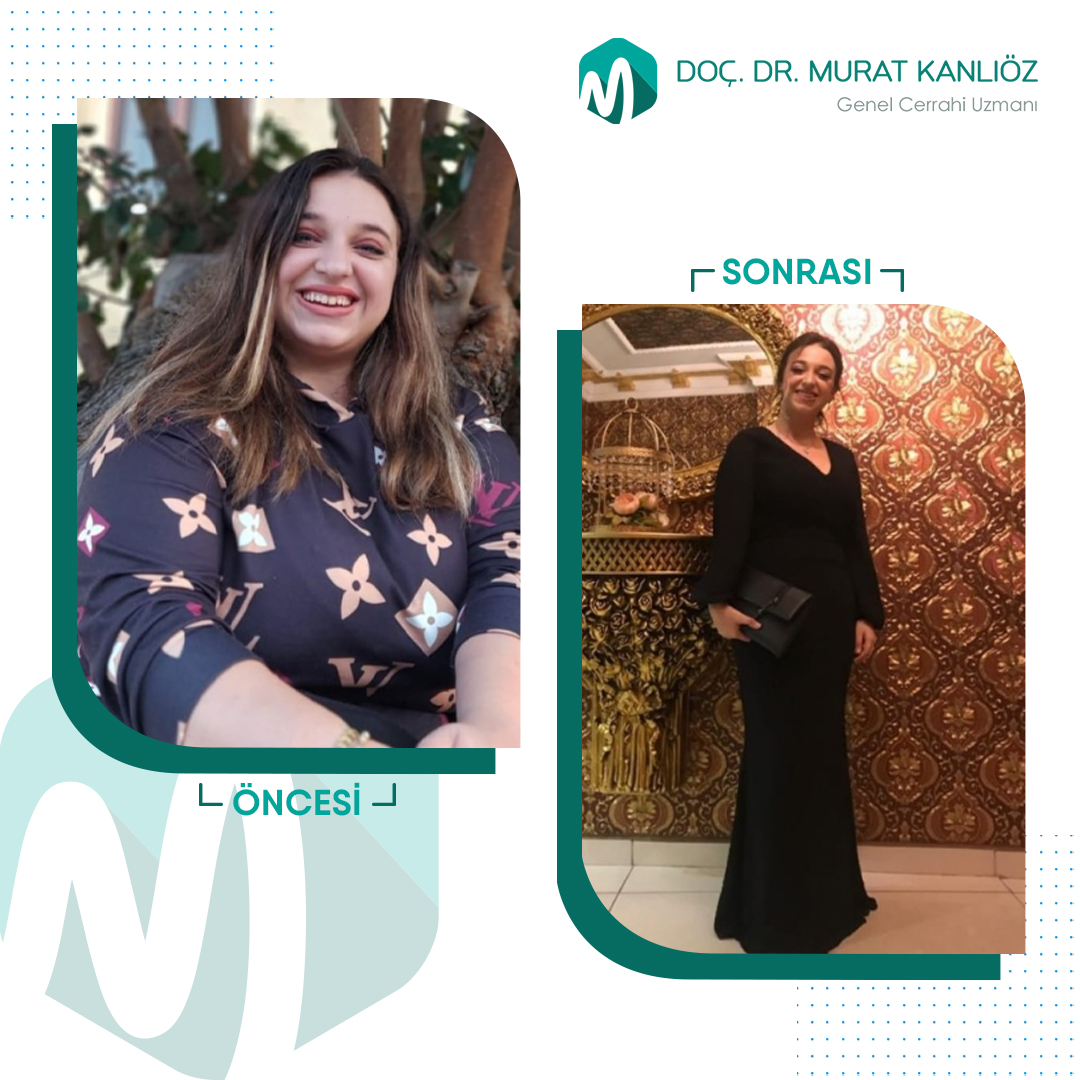
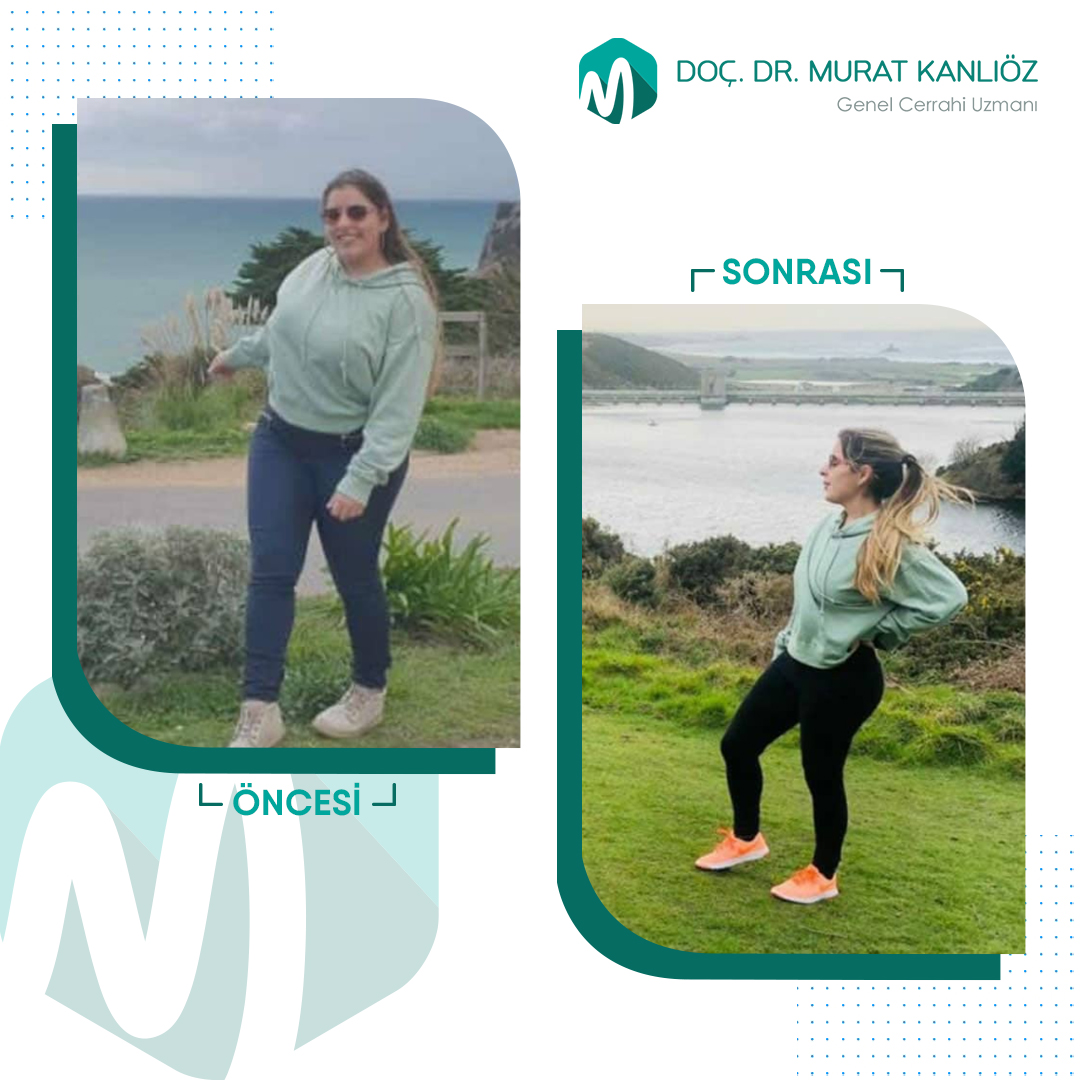
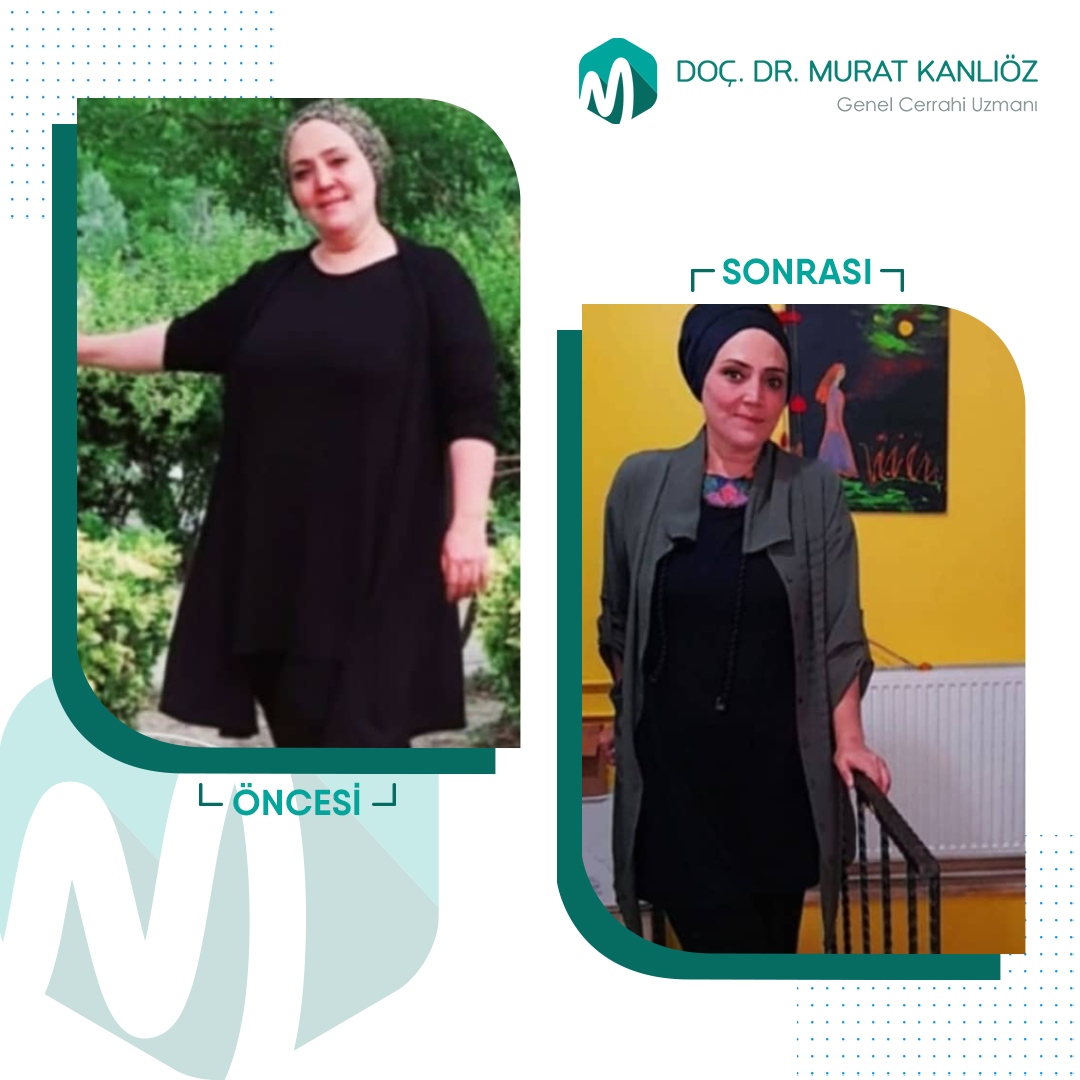
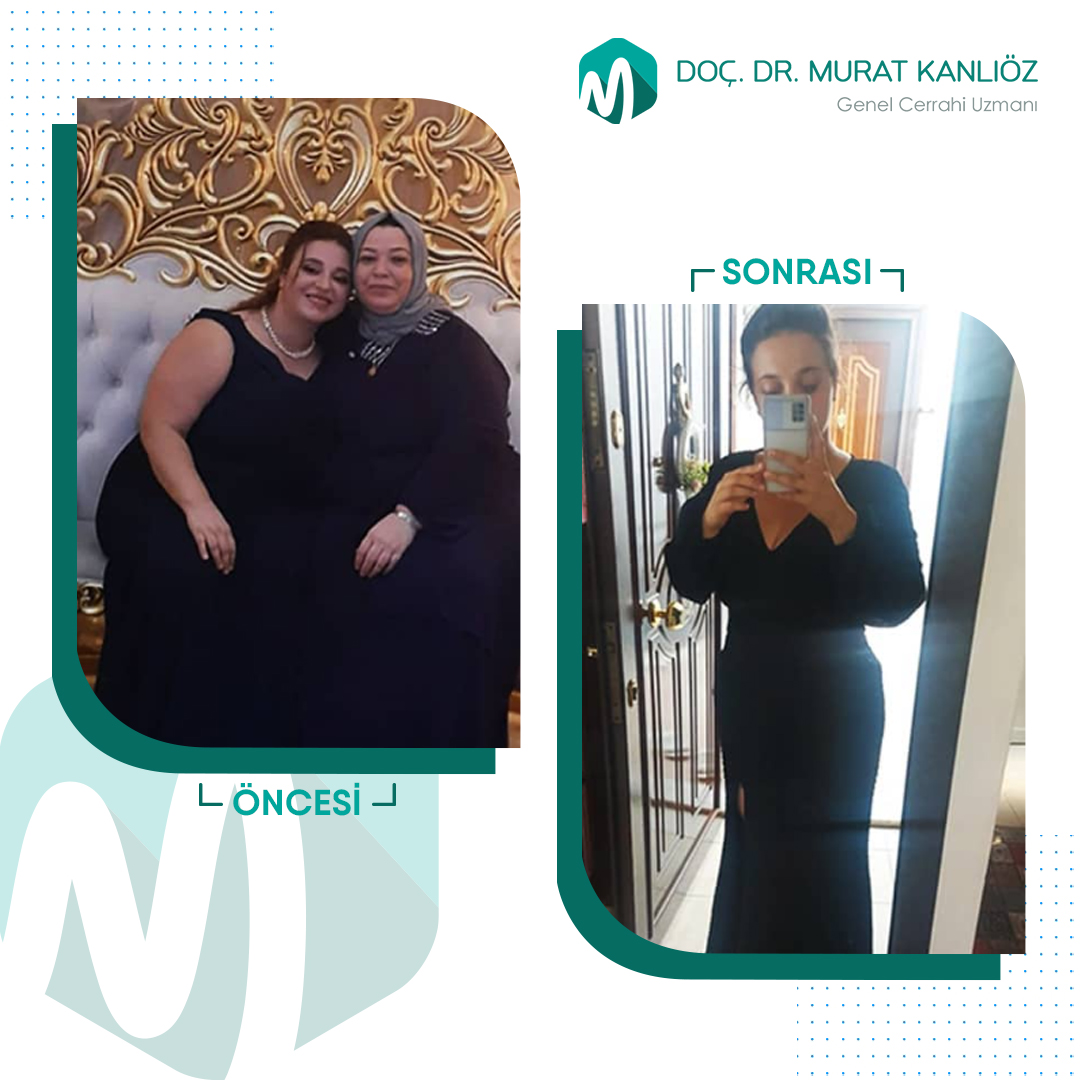
Frequently Asked Questions (FAQs)
It is possible to re-perform the KANLIOZ TECHNIQUE once its effects have disappeared. We can perform KANLIOZ TECHNIQUE again during the same session when the expired gastric balloon is removed. There are no medical drawbacks on the number of repeated procedures.
There are two types of gastric balloons. The first is a six-month gastric balloon, which is removed after this period. The other is a 12-month gastric balloon, which is removed after 12 months. However, no side effects appear if it stays 50% longer than the specified time.
The “Botulinum Toxin A” will cease to have any effect after about 6 months, so there is no need to do anything. However, the balloon placed in the stomach needs to be removed after 6 or 12 months, depending on the type.
